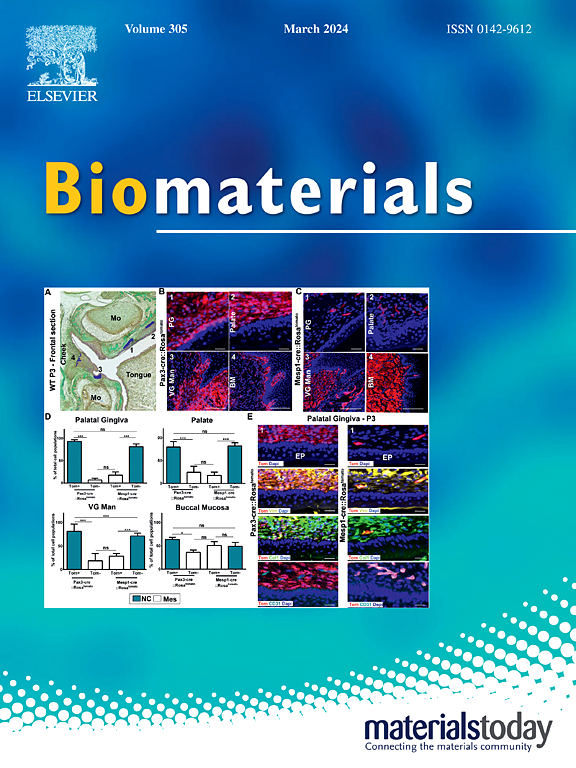Amplifying glioblastoma immunotherapy: T cell shielding through Nitric oxide/reactive oxygen species scavenging nanoparticles Potentiates anti-PD-1
IF 12.8
1区 医学
Q1 ENGINEERING, BIOMEDICAL
引用次数: 0
Abstract
Despite the success of immune checkpoint blockade (ICB) therapy in various cancers, its efficacy faces challenges in glioblastoma (GBM) due to the immunosuppressive cold-tumor microenvironment. The scarcity of tumor-infiltrating T cells and the suppression of T cell activity significantly limit therapeutic outcomes in GBM. Nitric oxide (NO) and reactive oxygen species (ROS) from tumor-associated myeloid cells (TAMCs) are key contributors to T cell suppression, reducing ICB therapy effectiveness. In this study, we developed NO-ROS scavenging micelles that effectively scavenge both NO and ROS, protecting T cells from their exhausting effects. This leads to a significant increase in T cell infiltration and activation. Moreover, when combined with αPD-1, the survival rate increases to 40 % up to 120 days, enhancing therapeutic efficacy compared to αPD-1 alone. This approach not only protects T cells from the inhibitory effects of NO and ROS but also has the potential to reshape the tumor microenvironment, overcoming T cell suppression in cold tumors.
增强胶质母细胞瘤免疫疗法:通过一氧化氮/活性氧清除纳米粒子保护 T 细胞 增强抗 PD-1 能力
尽管免疫检查点阻断疗法(ICB)在多种癌症中取得了成功,但由于免疫抑制性冷肿瘤微环境,它在胶质母细胞瘤(GBM)中的疗效面临挑战。肿瘤浸润 T 细胞的稀缺和 T 细胞活性的抑制极大地限制了 GBM 的治疗效果。一氧化氮(NO)和肿瘤相关髓系细胞(TAMCs)产生的活性氧(ROS)是抑制T细胞的关键因素,从而降低了ICB疗法的疗效。在这项研究中,我们开发了能有效清除 NO 和 ROS 的 NO-ROS 清除胶束,保护 T 细胞免受它们的衰竭效应。这导致 T 细胞浸润和活化明显增加。此外,与 αPD-1 结合使用时,存活率可提高到 40%,最长可达 120 天,与单独使用 αPD-1 相比,疗效更佳。这种方法不仅能保护 T 细胞免受 NO 和 ROS 的抑制作用,还有可能重塑肿瘤微环境,克服冷肿瘤对 T 细胞的抑制。
本文章由计算机程序翻译,如有差异,请以英文原文为准。
求助全文
约1分钟内获得全文
求助全文
来源期刊

Biomaterials
工程技术-材料科学:生物材料
CiteScore
26.00
自引率
2.90%
发文量
565
审稿时长
46 days
期刊介绍:
Biomaterials is an international journal covering the science and clinical application of biomaterials. A biomaterial is now defined as a substance that has been engineered to take a form which, alone or as part of a complex system, is used to direct, by control of interactions with components of living systems, the course of any therapeutic or diagnostic procedure. It is the aim of the journal to provide a peer-reviewed forum for the publication of original papers and authoritative review and opinion papers dealing with the most important issues facing the use of biomaterials in clinical practice. The scope of the journal covers the wide range of physical, biological and chemical sciences that underpin the design of biomaterials and the clinical disciplines in which they are used. These sciences include polymer synthesis and characterization, drug and gene vector design, the biology of the host response, immunology and toxicology and self assembly at the nanoscale. Clinical applications include the therapies of medical technology and regenerative medicine in all clinical disciplines, and diagnostic systems that reply on innovative contrast and sensing agents. The journal is relevant to areas such as cancer diagnosis and therapy, implantable devices, drug delivery systems, gene vectors, bionanotechnology and tissue engineering.
 求助内容:
求助内容: 应助结果提醒方式:
应助结果提醒方式:


